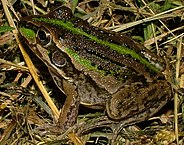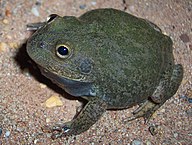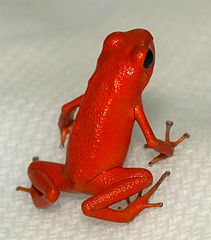An Australian frog that copes with droughts by entering a hibernation-like state known as aestivation is now the focus of important bio-medical research. Despite being immobile for months at a time, the Striped Burrowing Frog (Cyclorana alboguttata) suffers little of the muscle loss seen in immobile people, and in astronauts who spend long periods at reduced gravity. Two related frog species that I was lucky enough to acquire many years ago were also able to weather months without water, and in many ways seemed to be the ecological equivalent of another favorite of mine, the African Bullfrog.
The “African Bullfrogs of Australia”
The 13 squat, large-mouthed frogs in the genus Cyclorana are restricted to Australia, where many inhabit drought-prone regions that are inhospitable to other amphibians. Although classified with treefrogs in the family Hylidae, these odd beasts are about as far-removed from typical treefrogs as can be imagined – in fact, likely never see trees, considering where they live!
The two species that I’ve kept, the Water Holding Frog (C. platycephala) and the New Holland Frog (C. novaehollandiae), looked and acted like mini-African Bullfrogs. Capable of taking enormous meals (including same-sized tank-mates), they grew almost before my eyes. In the wild, most breed in temporary pools whenever it rains, eat like mad, store water in the bladder, and then disappear below ground. If the dry period is prolonged, a cocoon of shed skin will be formed about the body.
Muscle-Protecting Genes Discovered
The Striped Burrowing Frog has often been used as a model in studies seeking to slow or reverse muscle wasting in immobile people. Related studies have revealed that the loss of muscle tissue that occurs when we are unable to move is caused by protein-degrading molecules known as Reactive Oxygen Species.
Now, researchers at the University of Queensland have isolated a specific gene that seems to protect this frog’s muscle cells from damage during long periods of inactivity. As the gene, aptly named Survivin, is also found in humans, lessons learned by studying the frog could possibly be of benefit to us as well.
Another gene that may help to avoid muscle loss has also been identified. Known as Checkpoint Kinase 1, this gene regulates cell division and DNA repair. Researchers are also investigating the possibility that Striped Burrowing Frog muscles are assisted by high levels of protective antioxidants.
Applying these findings to human patients seems to be a long way off, but the research hold promise. In fact, similar muscle-protecting mechanisms have been found to be at work in hibernating mammals such as squirrels, which are a bit closer to us on the evolutionary scale.
I’ll pass along updates as they become available…please also share anything related that you may learn by posting below, thanks.
Further Reading
Amphibian learning Abilities (Toad Meets Bee)
 That Reptile Blog – Reptile, Amphibian and Exotic Pet Care and Information
That Reptile Blog – Reptile, Amphibian and Exotic Pet Care and Information






